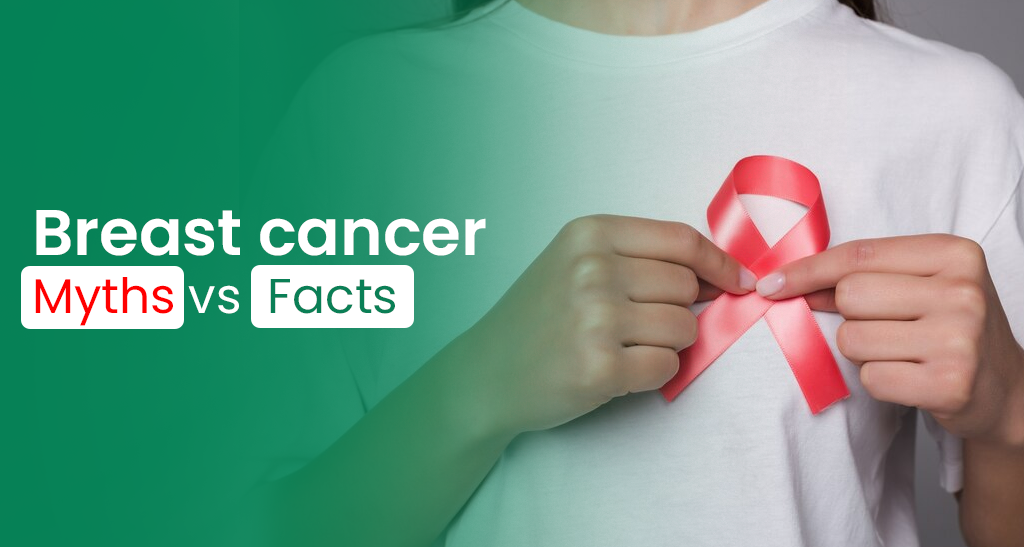Myths and misconceptions are common in any disease and disorder. Breast cancer is no exception. The myths surrounding can often be damaging and potentially hold back the person from getting the right treatment. So, people must understand and know the truth behind those myths.
Here are 10 of the most common myths and truths about breast cancer.
Myth: A person with no family history won’t be affected
Fact: Most individuals affected do not have a family history. It’s a common misconception that having a family history is the primary risk factor. Many cases basically occur in individuals with no known family history of the disease. While a family history can increase your risk, it is just one of many risk factors. Other factors, such as age, gender, and lifestyle choices also play a significant role in cancer risk.
Myth: Breast cancer is never curable.
Fact: It is treatable and often curable when detected in its early stages. Regular self-exams and screening mammograms can also help identify the disease at an early, more treatable phase. Early intervention, through surgery, radiation, chemotherapy, or targeted therapies, can significantly improve the chances of curing the disease completely.
Myth: Painless Lumps do not cause breast cancer.
Fact: Painless lumps are dangerous. They can cause cancer silently. The absence of pain in a breast lump doesn’t indicate that it’s harmless. Painless lumps can be indicative of cancer. It can develop without causing any discomfort, which is why any lumps should be taken seriously.
Myth: Breast cancer affects only women.
Fact: Breast cancer affects men as well. About 1 out of every 100 diagnosed cancer is found in a man. While it predominantly occurs in women, men can also develop breast cancer. Both men and women need to be aware of the risk, though the incidence is much lower in men. Any changes or abnormalities in the breast tissue should be evaluated, regardless of gender.
Myth: It is prevalent only in older women.
Fact: While most cases occur in middle-aged and older women, it can develop in young women as well. The risk increases with age, and women with a family history should start screening earlier than the recommended age. Regular screenings and a focus on breast health are also essential for women of all ages.
Myth: Any lump in the breast means breast cancer.
Fact: Not all lumps are cancerous. Some are benign, like fibroadenomas, which do not turn into cancer. Discovering a lump can be concerning, but it doesn’t always signify cancer. Many breast lumps are noncancerous. Consult with your doctor for proper diagnosis and evaluation.
Myth: Breast injury can cause breast cancer.
Fact: An injury to the breast cannot potentially cause breast cancer. These injuries may cause blood clots or internal bleeding, but they do not lead to the development of breast cancer. If cancer is discovered during an examination following an injury, it only means it was already there.
Myth: Mammograms can cause breast cancer.
Fact: Mammograms are screening tests to diagnose cancer, and while they involve radiation, there is no proven link between mammograms and causing cancer. Besides, Mammograms use low-dose X-rays to detect any abnormalities. While they involve radiation, the radiation levels used are very low and safe. Numerous studies have shown that the benefits of early detection through mammograms far outweigh any potential risks associated with radiation exposure.
Myth: Women with bigger breasts get breast cancer.
Fact: There’s no link between size and cancer development. However, the risk factors primarily associated which include age, gender, family history, genetics, and lifestyle factors like obesity. Obesity is a known risk factor but the size of an individual’s breasts does not impact their risk of developing the disease.
Conclusion
The risk of breast cancer and its impact is huge but the myths must be quashed to promote good breast health. Being informed and aware doesn’t make the cancer go away, but it equips us with all the information and knowledge to fight the disease and offers support to those who are battling it! Take a mammogram or our special Pink October package to check your breast health status.




